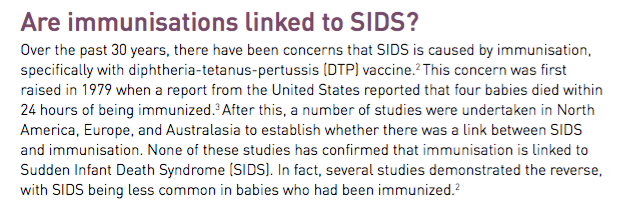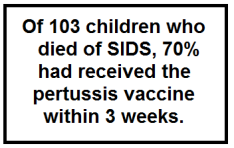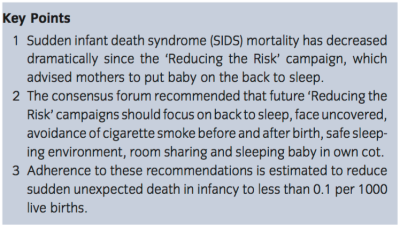From a typical anti-vaccine site pushing vaccine injuries:
These figures do not confirm causality. See explanation below ♣
One claim the anti-vaccine lobby use in their attack against the efficacy of the pertussis vaccine is the high uptake rate. The logic being that with high uptake and proper vaccine efficacy, pertussis should be better controlled than it is. In fact completely controlled. Thus the pertussis vaccine is a failure.
Whilst the vaccine may not provide impervious protection, infection of those vaccinated is much less common and markedly less severe.
And those not vaccinated against pertussis? According to Immunise Australia:
In a household where someone has whooping cough, an estimated 80-90% of the unimmunised contacts of that person will acquire the disease.
These realities won’t shift committed antivaccinationists. They will be convinced by the terribly misleading claim above, using unrelated figures on SIDS and pertussis vaccination. I find it astonishing anyone could be swayed by it. Yet for readers unskilled in finding reputable information or not prone to checking alarming claims it has an intuitive ring of causality.
♣ Infants receive vaccine doses at two, four and six months of age. 90% of SIDS cases occur in the first six months of life, and most of these in the first three months. The risk decreases consistently. After twelve months babies are by definition not infants and the risk of Sudden Unexplained Death is significantly reduced.
So the claim above merely sounds plausible because infants are most at risk of SIDS up to six months. Over this time they have three pertussis vaccines. The vast majority of children in developed nations will follow the pertussis vaccination schedule.
SIDS and Kids is an Australian organisation that supports educating the public about the “significantly” reduced risk of SIDS that accompanies immunisation. They have also noted that when the age of first immunisation was lowered by four weeks there was no lowering of the average age of SIDS.
 Download the full SIDS and Kids PDF Information Statement – Immunisation
Download the full SIDS and Kids PDF Information Statement – Immunisation
German research published in Vaccine in 2007 indicates that immunisation notably reduces the risk of SIDS. Vennemann et al concluded in Do immunisations reduce the risk of SIDS? A meta-analysis (bold mine):
Immunisations are associated with a halving of the risk of SIDS. There are biological reasons why this association may be causal, but other factors, such as the healthy vaccine effect, may be important. Immunisations should be part of the SIDS prevention campaigns.
A constant assertion from the anti-vaccine lobby is that of “too many, too soon”, contending that modern vaccine schedules overwhelm infants and children in a manner yet to be uncovered. An earlier study by Vennemann et al, Sudden infant death syndrome: No increased risk after immunisation found no evidence for this but rather the opposite.
- Results:
SIDS cases were immunised less frequently and later than controls. Furthermore there was no increased risk of SIDS in the 14 days following immunisation. There was no evidence to suggest the recently introduced hexavalent vaccines were associated with an increased risk of SIDS.
- Conclusion:
This study provides further support that immunisations may reduce the risk of SIDS.
A number of studies have been conducted in Australasia, North America and Europe. All confirm that immunisation is not causally linked to SIDS. Thus early immunisation is coincidental to the age at which SIDS is most likely. In fact the reverse is true with respect to causality. SIDS cases are less likely to be immunised or fully immunised. Unlike most “vaccine injuries” this favourite fear tactic of antivaccinationists does have an origin in a published report.
The CDC Morbidity and Mortality Weekly Report 1979; 28: 131-132 noted in DTP vaccination and sudden infant deaths – Tennessee that four babies had died within 24 hours of being immunised. The following Weekly Report clarifies (pp. 134-135) under Follow-up on DTP vaccination and sudden infant deaths – Tennessee:
Further examination of the vaccination histories of infants who died suddenly has revealed no additional instances of vaccination within 24 hours before death.Thus, 4 deaths have been found that occurred within 24 hours after receipt of vaccine from Lot No. 64201, compared with no deaths within 24 hours after DTP vaccination in the earlier 8-month period in Tennessee.
All controlled studies that have compared immunized versus nonimmunized children (Table 5-1) have found either no association (Bouvier-Colle et al., 1989; Pollock et al., 1984; Taylor and Emery, 1982) or a decreased risk (Hoffman et al., 1987; Walker et al., 1987) of SIDS among immunized children.[…]One small controlled study of infants with unexplained apnea, who may be at increased risk for SIDS, demonstrated improvement in ventilatory patterns following DPT immunization (Keens et al., 1985).
- Conclusion
The evidence does not indicate a causal relation between DPT vaccine and SIDS. Studies showing a temporal relation between these events are consistent with the expected occurrence of SIDS over the age range in which DPT immunization typically occurs.
It’s important to note that at this stage no research demonstrating a reduction in SIDS due to immunisation had been published. Consequently the authors do not mention this effect.
In 1995 E.A. Mitchell et al examined the association between immunisation and SIDS. They observed there is no increased risk of SIDS following the Hepatitis B immunisation or the 6 week DTP immunisation. They also noted early studies suggesting an increased risk of SIDS with immunisation had no control data. Two studies with controls that suggested such a temporal link demonstrated methodological bias.
Mitchell et al concluded:
Immunisation does not increase the risk of SIDS and may even lower the risk.
Jacqueline Muller-Nordhorn et el published Association between SIDS and DTP immunisation: an ecological study [10.1186/s12887-015-0318-7]. The aim was to analyse this association over time. The body of the paper’s Discussion included;
- SIDS mortality rates have been inversely associated with DTP immunisation coverage in the United States over recent decades
- The most notable decreases in SIDS rates occurred from 1991 onwards, coinciding with increases in DTP immunisation
- In 2011, the Task Force on Sudden Infant Death Syndrome included immunisation as one of the recommendations to reduce the risk of SIDS [Citation]
- However, recommendations to the public and the ‘grey literaure’ often do not include immunisation in the prevention of SIDS. Prevailing safety concerns with regard to immunisation may have played a role in this hesistance for many years
- DTP immunisation may protect against SIDS by preventing infection with Bordetella (B.) pertussis. SIDS might thus be undiagnosed pertussis
- In approximately 50–80% of SIDS cases, signs of upper and lower respiratory tract infection, characterised by a mild cellular infiltrate, have been found
- Furthermore, similar to DTP immunisation, OPV immunisation was associated with a reduced risk of SIDS. Case–control studies have associated a similar reduction in SIDS risk with DTP and OPV immunisation, whereas less evidence is available regarding Hib immunisation
- In addition to the pertussis component, DTP includes diphtheria and tetanus components. Certain countries, such as England and Sweden, previously experienced major decreases in pertussis immunisation but administered diphtheria and tetanus vaccines separately, thus maintaining high coverage
- The SIDS trends in these countries were similar to the trends in the United States. Thus, diphtheria and tetanus immunisation seem less likely to be associated with SIDS
DTP immunisation is inversely associated with SIDS mortality on the population level. The current findings may strengthen parents’ confidence in the benefit of DTP immunisation, especially as they are supported by the results of two meta-analyses*.
*See Vennemann et al, above.
October 2010 saw the Scientific consensus forum to review the evidence underpinning the recommendations of the Australian SIDS and Kids Safe Sleeping Health Promotion Programme [PDF]. This Position Paper is published in the Journal of Paediatrics and Child Health [doi:10.1111/j.1440-1754.2011.02215.x]
The document is an excellent publication covering the evidence and recommendations that apply to reducing SIDS. On page three the topic of Immunisation is addressed:
Parents are advised to immunise their babies according to the national vaccination schedule. The possibility of the DTP (diphtheria-tetanus-pertussis) vaccination being linked to SIDS has been discussed periodically over the last 20 years, however a series of studies have consistently refuted the association. A recent meta-analysis published provides strong evidence that immunisation is associated with a decreased risk of SIDS (OR 0.54; 95% CI = 0.39–0.76).
We should note that the delightfully immoral antivactionist and author of Melanie’s Marvellous Measles, Stephanie Messenger was involved in peddling a long debunked “prevention” for SIDS. In fact SIDS and Kids have their own evidence based and comprehensive publication outlining why mattress wrapping offers no protection. A March 2003 article in Pediatric and Developmental Pathology, SIDS: Overview and Update offers evidence to debunk both the “mattress toxin” myth and proposed links to immunisation (p. 121).
In 1989 in the UK Barry Richardson contended that the fungus Scopularis brevicaulis broke down fire retardant chemicals in mattresses or their PVC covers. This produced arsine, phosphine and stibine gases from antimony, phosphorous and arsenic. A UK study failed to replicate Richardson’s findings. A follow up study with Richardson’s collaboration also failed to duplicate the proposed findings.
I highly recommend reading the SIDS and Kids information sheet on this pseudoscientific mess and the conspiracy hovering over it. In May 1998 an Expert Group to Investigate Cot Death Theories: Toxic Gas Hypothesis, UK examined all available evidence and found:
…there is no evidence to suggest that antimony or phosphorus containing compound used as fire retardant in PVC and other cot mattress materials are a cause of sudden infant death syndrome.
This conclusion is based upon the following:
- Cot mattress contamination with the fungus S. brevicalis is rare, and no more common in SIDS mattresses than in other used mattresses.
- There is no evidence for the generation of gases from phosphorus, arsenic and antimony from cot mattresses, by S. brevecaulis, when tested using conditions relevant to a baby’s cot. (the group did, however, identify laboratory conditions, wholly unlike those that could occur in a baby’s cot, in which added antimony is biovolatilised, but to the much less toxic trimethylantimony and not to stibine).
- There is no evidence of poisoning by phosphine, arsine, or stibine (or bethylated derivatives) in babies who have died of SIDS.
- Low amounts of antimony can be detected in samples from the majority of live babies, and even newborn babies: the concentrations in the tissues of SIDS babies were not different from those dying from known causes. there are a number of sources of antimony in the domestic environment other than the fire retardant in cot mattress materials.
- We have found no evidence that the changing rates of sudden infant death correspond to the introduction and removal of antimony – and phosphorus – containing fire retardant in cot mattresses.
SIDS and Kids also mention the conspiracy book Cot Death Cover-up? by N.Z. forensic chemist Jim Sprott. Stephanie Messenger also mentioned this book at her secret seminars wherein she peddled her “mattress covers” to protect against SIDS. There is a fascinating February 2012 account of a conspiracy laden seminar on the Skeptimite blog. In April of this year it was reported that Messenger had the charity status of her “SIDS charity” Get Rid Of SIDS revoked.
Just as well one feels. Not only because the scam had done no charity work and employed nobody. Messenger had gone from blaming vaccination for SIDS to pushing the phoney toxic gas theory as the cause – 20 years after it was first debunked and progressively relegated to conspiracy theory. When Messenger’s plan to bring the very harmful anti-vaccine heroine Sherri Tenpenny to Australia, she then advocated readers purchase her pro-measles book to help her out of debt.
Ultimately nothing has changed with respect to the anti-vaccine claim that SIDS is caused by vaccines. In fact evidence supporting the opposite remains firm.
We may also rest assured that mattress wrapping is an evidence free, conspiracy based waste of time.



